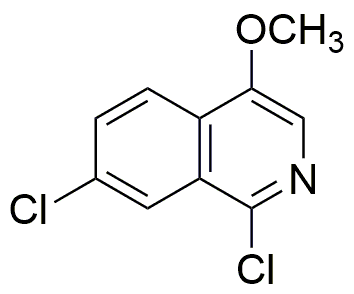1,7-Dichloro-4-methoxyisoquinoline is widely utilized in research focused on:
- Pharmaceutical Development: This compound serves as a valuable intermediate in the synthesis of various pharmaceuticals, particularly in the development of drugs targeting neurological disorders.
- Antimicrobial Research: It has shown potential as an antimicrobial agent, making it useful in the formulation of products aimed at combating bacterial infections.
- Biological Studies: Researchers use it to study its effects on cellular mechanisms, which can lead to insights into cancer treatment and other diseases.
- Material Science: The compound is explored for its properties in creating novel materials, such as polymers or coatings, that require specific chemical stability and reactivity.
- Analytical Chemistry: It is utilized as a standard in analytical methods to quantify related compounds, ensuring accuracy in research and quality control processes.
Información general
Propiedades
Seguridad y normativas
Aplicaciones
1,7-Dichloro-4-methoxyisoquinoline is widely utilized in research focused on:
- Pharmaceutical Development: This compound serves as a valuable intermediate in the synthesis of various pharmaceuticals, particularly in the development of drugs targeting neurological disorders.
- Antimicrobial Research: It has shown potential as an antimicrobial agent, making it useful in the formulation of products aimed at combating bacterial infections.
- Biological Studies: Researchers use it to study its effects on cellular mechanisms, which can lead to insights into cancer treatment and other diseases.
- Material Science: The compound is explored for its properties in creating novel materials, such as polymers or coatings, that require specific chemical stability and reactivity.
- Analytical Chemistry: It is utilized as a standard in analytical methods to quantify related compounds, ensuring accuracy in research and quality control processes.
Documentos
Hojas de datos de seguridad (HDS)
La SDS proporciona información de seguridad completa sobre la manipulación, el almacenamiento y la eliminación del producto.
Especificación del producto (PS)
La PS proporciona un desglose completo de las propiedades del producto, incluida la composición química, el estado físico, la pureza y los requisitos de almacenamiento. También detalla los rangos de calidad aceptables y las aplicaciones previstas del producto.
Certificados de análisis (COA)
Busque certificados de análisis (COA) ingresando el número de lote del producto. Los números de lote y de partida se pueden encontrar en la etiqueta de un producto después de las palabras "Lote" o "Lote".
Número de catálogo
Número de lote/lote
Certificados de origen (COO)
Este certificado de origen confirma el país en el que se fabricó el producto y también detalla los materiales y componentes utilizados en él y si se deriva de fuentes naturales, sintéticas u otras fuentes específicas. Este certificado puede ser necesario para cumplir con las normativas aduaneras, comerciales y regulatorias.
Número de catálogo
Número de lote/lote
Hojas de datos de seguridad (HDS)
La SDS proporciona información de seguridad completa sobre la manipulación, el almacenamiento y la eliminación del producto.
DownloadEspecificación del producto (PS)
La PS proporciona un desglose completo de las propiedades del producto, incluida la composición química, el estado físico, la pureza y los requisitos de almacenamiento. También detalla los rangos de calidad aceptables y las aplicaciones previstas del producto.
DownloadCertificados de análisis (COA)
Busque certificados de análisis (COA) ingresando el número de lote del producto. Los números de lote y de partida se pueden encontrar en la etiqueta de un producto después de las palabras "Lote" o "Lote".
Número de catálogo
Número de lote/lote
Certificados de origen (COO)
Este certificado de origen confirma el país en el que se fabricó el producto y también detalla los materiales y componentes utilizados en él y si se deriva de fuentes naturales, sintéticas u otras fuentes específicas. Este certificado puede ser necesario para cumplir con las normativas aduaneras, comerciales y regulatorias.


